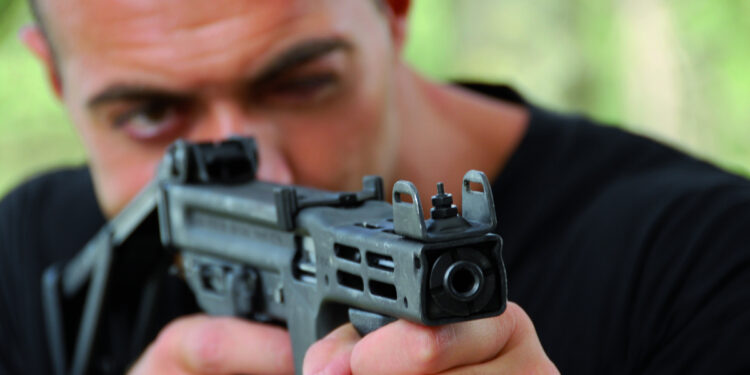A child of Italian 1980s firearms manufacturing, the SITES Spectre M4 sub-machine gun was perhaps too different for its time.
by Pierangelo Tendas
From 1969 to 1988, Italy bore the brunt of the wave of political terrorism that hit Europe as a whole: bombings, shootings, kidnappings, robberies, and attacks against law enforcement, politicians, and magistrates by both extreme left-wing and extreme right-wing militant armed groups ended up killing over 400 people and wounding well over 1000. On top of this, the 1970s saw the rise of international terrorism, particularly by radical Middle Eastern groups; from 1973 to 1989, attacks by Palestinian terrorists against Italy and Italian assets all through the world killed 66 people and wounded more than 130.
Just like their counterparts more or less all over the world, the Italian firearms industry went on to study numerous solutions that could integrate the lessons learned from both the experience of law enforcement operators and that of the militaries in the recent conflicts around the globe – last but not least, the American experience in Vietnam – into practical solutions to tackle this kind of threat. Some would be more commercially successful than others, although, as in many other cases, more often than not, the most interesting products would be the brainchild of this or that underdog.

Headquartered in the city of Turin, the Società Italiana Tecnologie Speciali S.p.A. company (“Italian Company for Special Technologies, Ltd.”), best known by the acronym SITES, was established and led by two engineers – Roberto Teppa and Claudio Gritti, with a third engineer, Franco Manassero, acting as the CEO – spent some time evaluating the pros and cons of existing firearms in an attempt to create what would be the best all-round sub-machine gun for all law enforcement uses… from patrol (most law enforcement back in the day, and still today, relying on SMGs as their patrol long guns in lieu of the shotguns and semi-automatic carbines more popular in the U.S.) to close protection, from special operations to counter-insurgency.
The first iteration of their project, called the Spectre Model 2, was first showcased in 1983 and began production in 1985. By 1988, a few modifications concerning the manufacturing specs of certain components were implemented; the changes are detailed in our article by J.M. Ramos published on SAR V4N8 (May 2001), Volume 4. The result, dubbed the Model 4 – or SITES Spectre M4 for short – was manufactured by SITES from 1988 to 1998, with some variants still being assembled as late as in 2001.
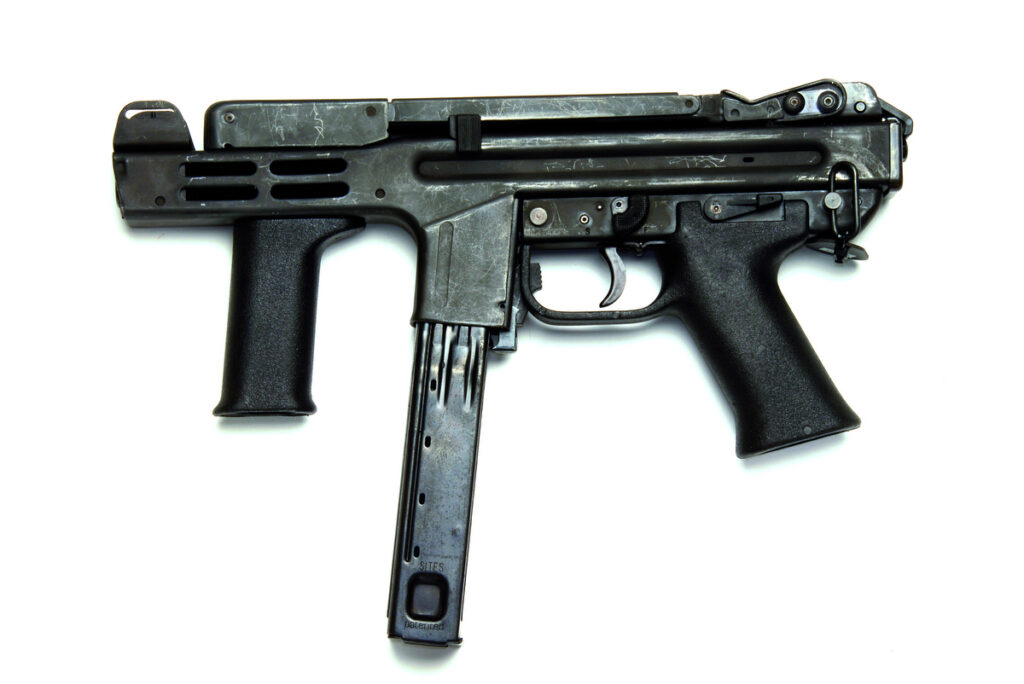
Italian Innovation
In the highly competitive field of small arms manufacturing of the 1980s, the SITES Spectre was a blend of tradition and innovation. Built around a stamped steel receiver, with a trigger group assembly manufactured out of the same materials and very little synthetic components outside of the pistol grip and its foregrip, the Spectre wasn’t a featherweight by a long shot, weighing in at 2.9 kilograms (about 6.4 pounds) when empty.
What made it absolutely unique was its technical layout. Teppa and Gritti wanted the SITES Spectre to be ready to deploy and operate at a moment’s notice, without sacrificing performance, reliability, or safety. As strange as it seems, they did so by doing without a manual safety. The SITES Spectre was the world’s first sub-machine gun – and as of today, it remains the only mass-produced SMG – to employ a SA/DA trigger with no external safety, replaced by a decocker.

A half-moon selector, located right above the trigger guard on both sides and activated by the shooter’s index finger, only provided two positions – “S” for semi-automatic, and “F” for full-automatic. An ambidextrous lever located at thumb reach over the pistol grip could be activated to decock the gun, requiring a deliberate, long trigger pull to fire off the first shot, with all subsequent shots being fired in single-action. This made accidental or negligent discharges of the SITES Spectre basically impossible while still keeping the gun always ready for action.
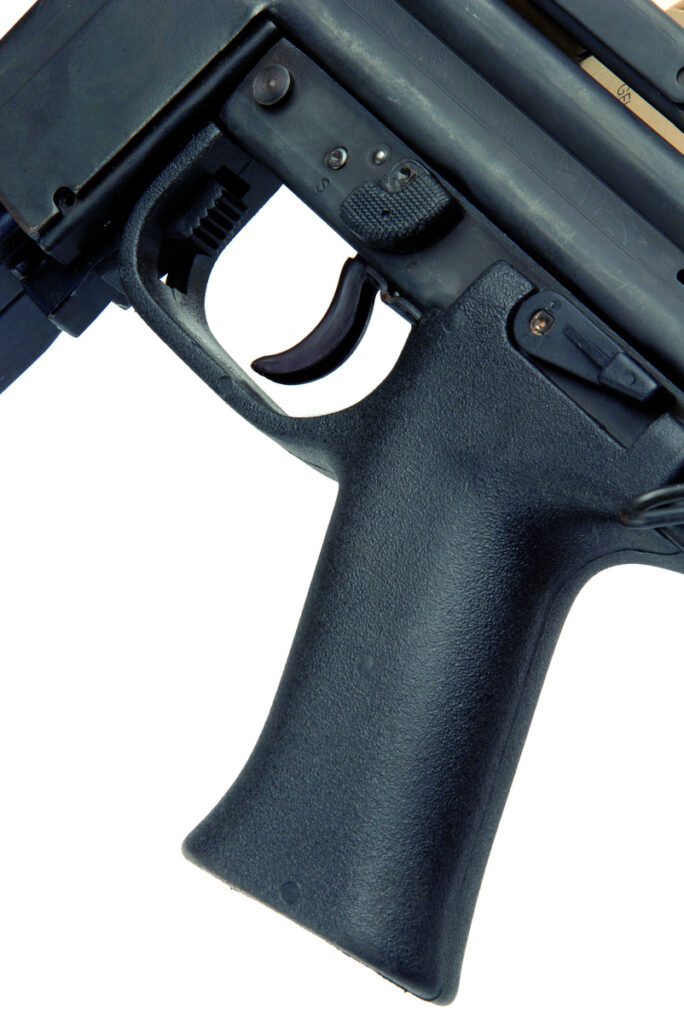
The SITES Spectre was a hammer-fired, delayed-blowback, closed bolt design, with a peculiar two-part bolt and a dual recoil spring. When a round is chambered, the front portion of the bolt, which also houses the firing pin and the extractor, moves forward while the rear portion remains locked back, engaged to the sear, and acts as a hammer, to be released on the striker when the trigger is pulled. Both components travel rearwards together after the SMG is fired, but once the empty case is extracted and ejected, only the front portion slams back forward, loading a fresh round in chamber while the rear portion engages the sear and stays locked back until the trigger is pulled again. The timing of the interaction between these two separate masses creates the opening delay that makes the SITES Spectre safe for use in all calibers it was built for – but we’ll talk about those later.
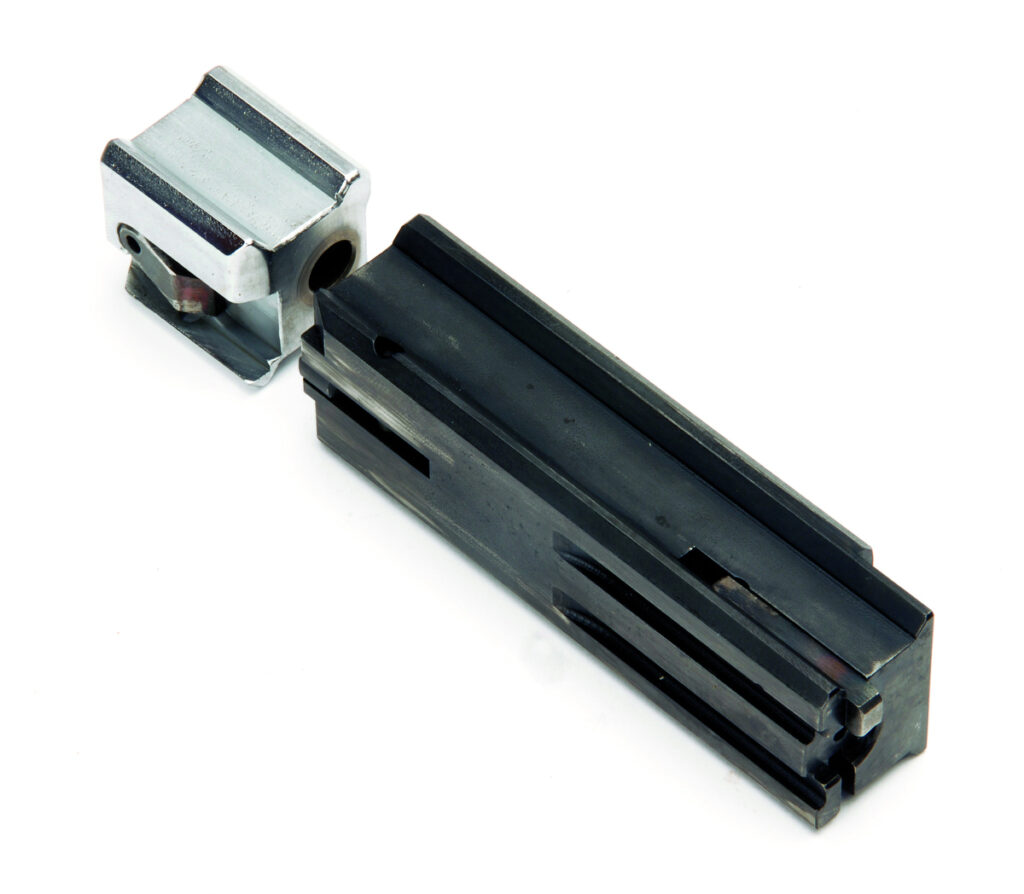
Additionally, the two-part bolt was advertised as a “forced convection” device, a safety feature against overheating: the alternate movement of the two components would pump air around the chamber and the barrel, reducing the temperature of the system during sustained fire and thus the danger of a cook-off. That may seem redundant – a closed-bolt firearm is definitely more prone to cook-off than an open-bolt firearm, but a sub-machine gun is hardly the kind of weapon that will likely experience a cook-off – but, if anything, the bolt design also had the advantage of reducing moving masses at any given time, thus making the SITES Spectre extremely stable and controllable, with very low felt recoil and muzzle climb, and reliable even with high or very high-pressure ammunition (it was rated for 9mm Luger up to +P+ by the Italian military and government entities that procured it.)
Readily Ambidextrous, Suppressor-ready
Aside from the previously mentioned ambidextrous selector and decocker, the only other controls on the SITES Spectre are the non-reciprocating charging handle and the magazine release catch.

The former is located on top of the receiver and consists of a flat polymer lever with two serrated studs on both sides. An improvement from the first-iteration Model 2 (which featured an UZI-style cocking knob), the charging handle of the SITES Spectre M4 can be operated by the shooter’s index finger and thumb, with either hand, and doesn’t interfere with the sighting plan, nor with the position of the buttstock.
The magazine release is a flat button located within the trigger guard, just behind the magazine well, and by pushing it with their trigger finger, the shooter releases the hook that retains the magazine in place. Both controls can be operated by left-handed or right-handed shooters, making the SITES Spectre one of the very first fully ambidextrous firearms of modern times.

The SITES Spectre M4 fed through proprietary quad-stack, single-feed magazines manufactured out of sheet metal, inspired (at least in concept, if not officially) by the Finnish Suomi KP/31 “coffin” mags, and offered in two capacities – 30 and 50 rounds. The 30-round magazine was as tall as a pack of cigarettes, while the 50-round mag was as long as a standard 30- or 32-round mag used by any other SMG of the time. Reduced masses made the SITES Spectre more easily concealable – a plus for law enforcement operators working close protection details – while still packing enough ammunition to engage in sudden, high-intensity firefights and get the upper hand.

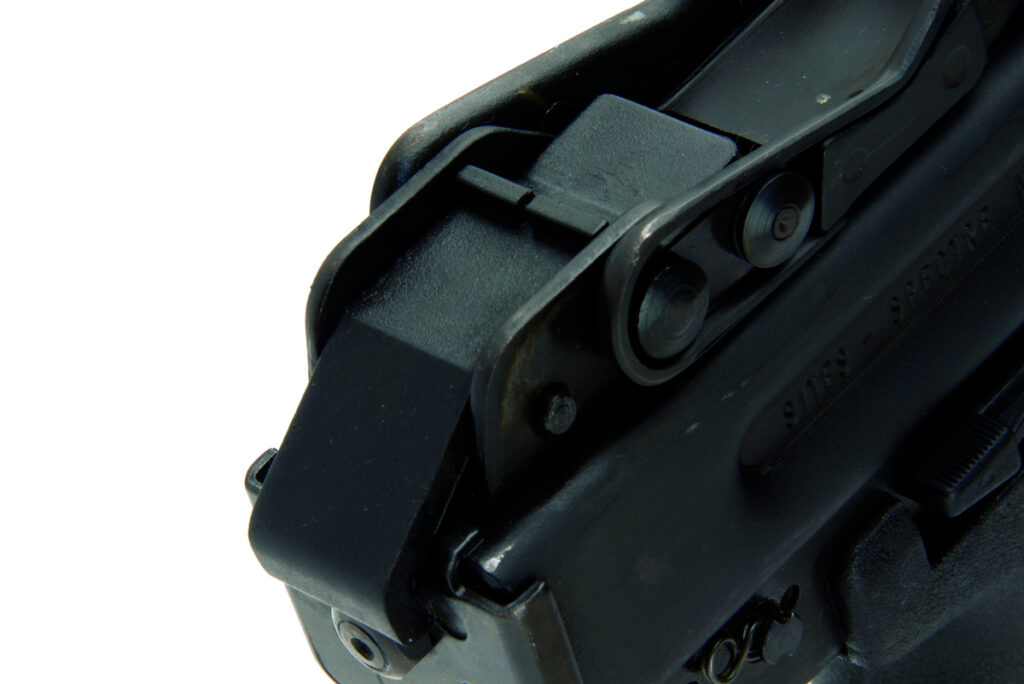
The SITES Spectre was fitted from factory with a 13 cm (5.11-inch) barrel, with a rather unusual sinusoidal rifling; similar in concept to the Sabatti MRR Multi-Radial Rifling pattern of modern manufacture, the SITES Spectre’s sinusoidal rifling consisted essentially of polygon rifling with softer edges between lands and grooves, which the bullet was thus allowed to fill better, acting as a gas seal as it traveled through the barrel, allowing very little (if any) gas to escape around the lands and maximizing propulsion efficiency.
Upon request, the SITES Spectre M4 could be obtained with a slightly longer, threaded barrel that would take a purpose-built silencer, manufactured entirely out of steel and dubbed the EM-F2. The sinusoidal rifling and the “gas seal effect” it achieved made the EM-F2 suppressor particularly effective, even with supersonic loads.
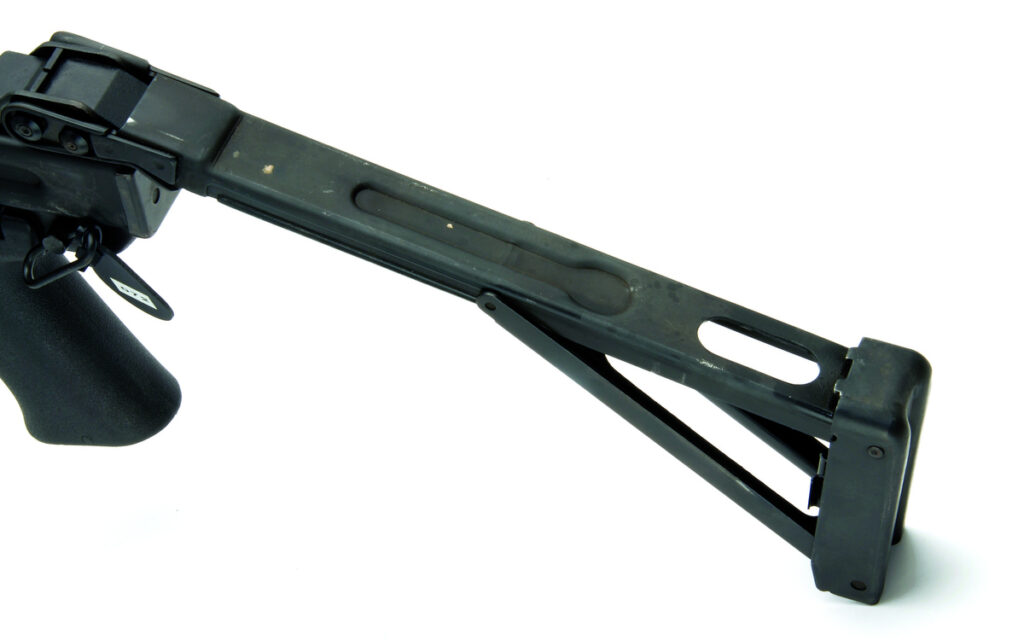
The SITES Spectre came from factory with an up-folding sheet metal stock, held in the closed position by a metal clamp that engaged the top ventilation holes of the barrel shroud and was thus very easy to deploy and not nearly as uncomfortable as other sheet metal stocks of sub-machine guns from the same era. The stock was cut on top – a reminiscence of the Model 2 pre-production model, where the stock had to have clearance for the UZI-style cocking knob – and even when closed, provides unobstructed view of the sights, specifically a fixed polymer rear sight and an elevation-adjustable front post, zeroed from factory for a 50-meter range (about 164 feet).
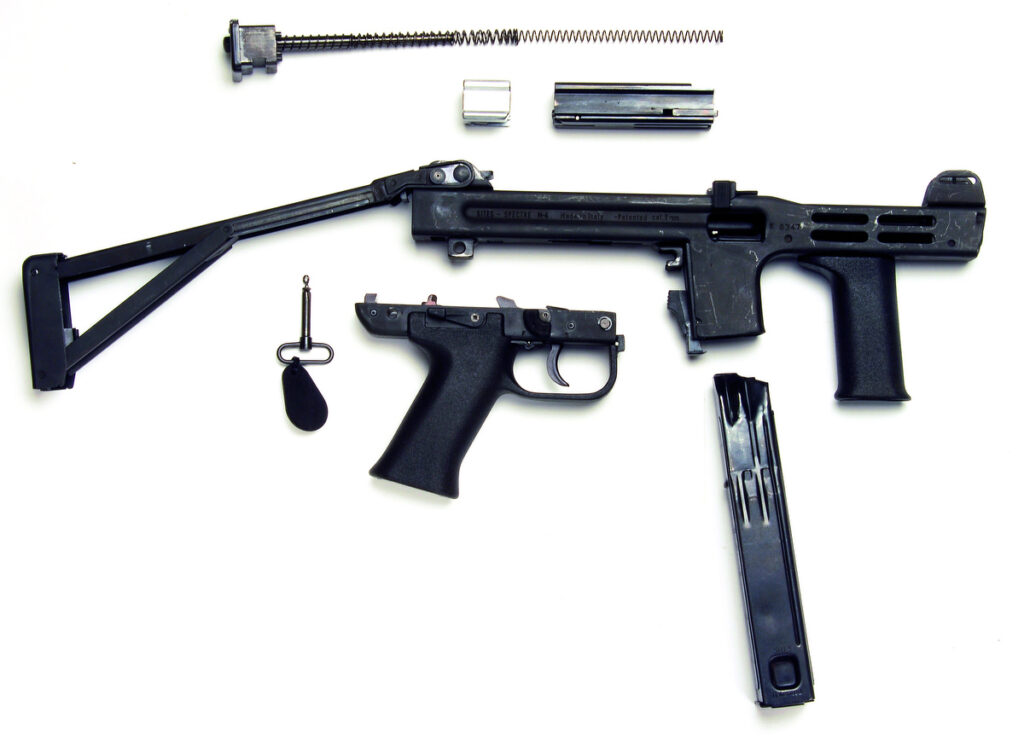
The SITES Spectre M4 strips very easily: with the chamber clear, hammer down, and magazine removed, the user only needs to open the stock and pull out the passing pin that integrates the rear sling swivel – which can be installed to the rear or left side, by the way – in order to remove the receiver end cap with the recoil springs and guide rods and slide the two-part bolt out. At this point, the entire trigger group assembly is removed from the bottom of the receiver. Additional stripping includes the removal of the barrel, which requires the use of a hex key to loosen the barrel retaining block nut.
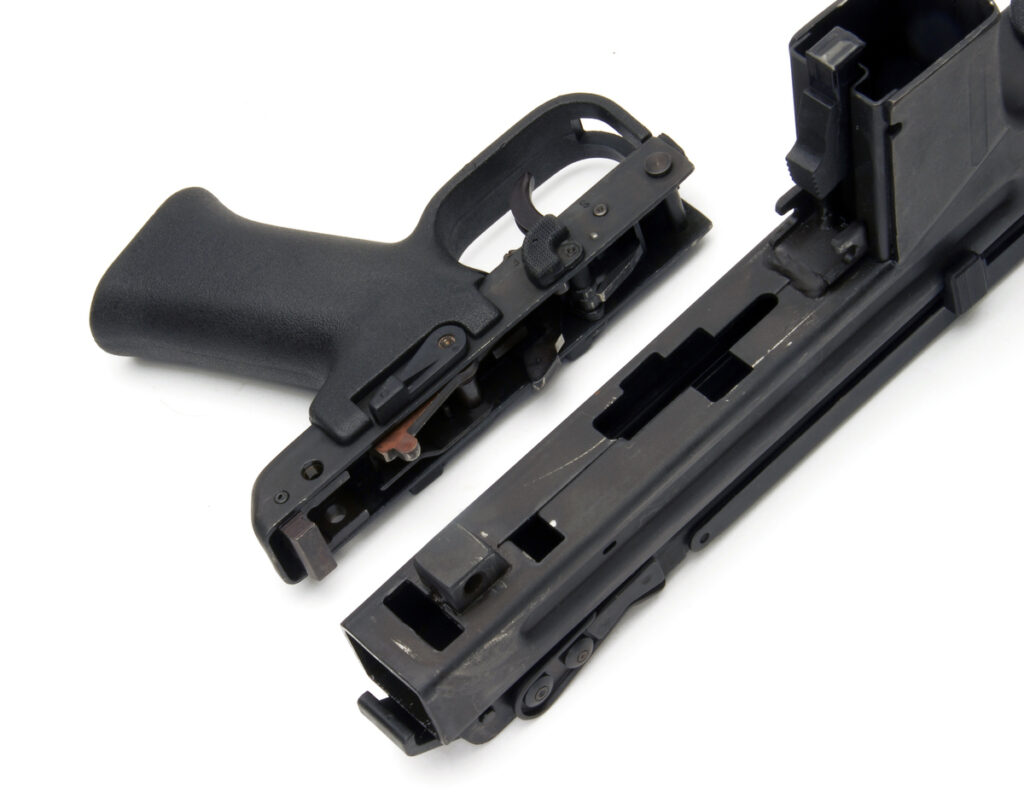
Multicaliber… But Not Exactly
The SITES Spectre M4 was initially advertised as being available in three calibers: 9mm Luger, 45 ACP, and later, 40 Smith & Wesson. In reality, virtually all the select-fire Spectres still in existence are in 9mm Luger, and their recorded cyclic rate in full-automatic fire ranges between 850 and 900 rounds per minute, with the utmost level of reliability; the issues with the selector experienced by a well-known Guntuber with a full-automatic SITES Spectre in early August this year are to be attributed to the wear and tear and lack of maintenance of the individual firearm being tested rather than to inherent engineering or manufacturing issues.
The ergonomics of the SITES Spectre M4 were very reminiscent of those of the Beretta PM-12S, Italy’s main service sub-machine gun of the day. The Spectre might have been considered significantly superior due to the closed bolt operation and ambidextrous capabilities, but its lack of widespread acceptance and adoption among Italian government, military and law enforcement customers came down to the Italian authorities’ long-rooted reluctance in subjecting their personnel to extensive retraining. This, and in the fact that SITES was, after all, a small company, incapable of meeting the production volumes that a major government contract would entail.

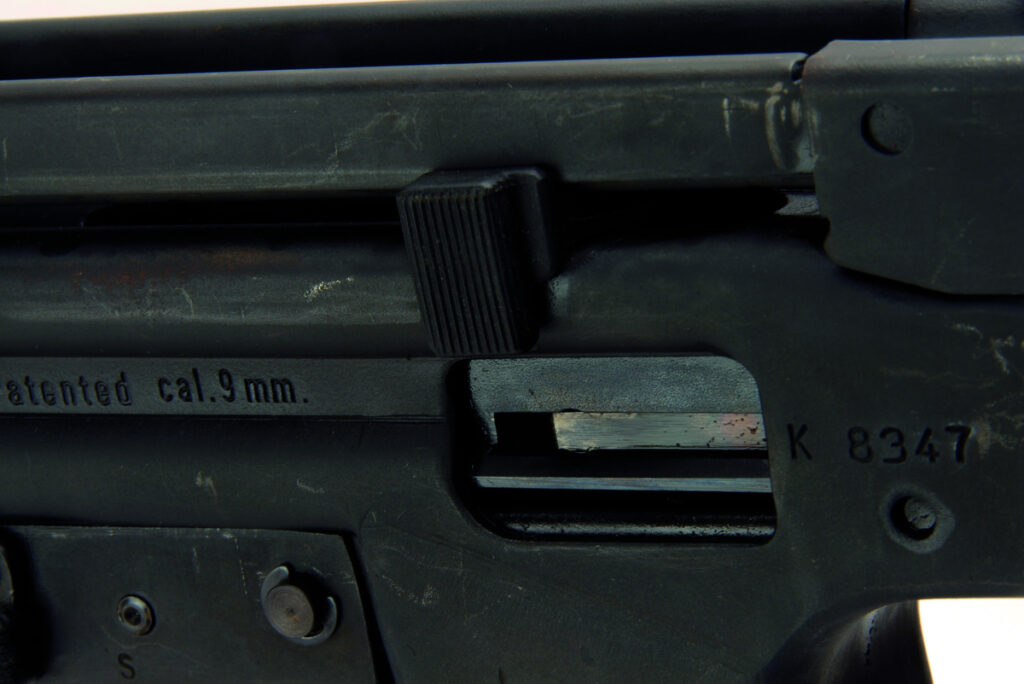
This said, certain special units within the Italian military and law enforcement communities did procure significant quantities of the SITES Spectre M4, which was deployed as late as during the Italian participation to ISAF and the circa 2015 Resolute Support Mission in Afghanistan. Confirmed international customers include Switzerland, France, and in the early 1990s, the South African Defence Forces and the governments of the freshly independent Croatia and Bosnia and Herzegovina.
SITES also manufactured three semi-automatic variants of the Spectre M4 for international commercial sales to civilian shooters and private security personnel, dubbed respectively the “Falcon,” the “Spectre HC,” and the “Ranger.”
The SITES Falcon was the civilian version of the Spectre M4 as sold in Italy; chambered in 9×21 IMI but also available in 40 Smith & Wesson and 45 HP (45 ACP would remain banned for civilians in Italy until the year 2000 and 9mm Luger wouldn’t be made legal until the year 2022), the Falcon was an outright Spectre M4, with the lack of select-fire capabilities but retaining the original foregrip and upfolding sheet metal stock.
The Spectre HC was the version for the U.S. civilian market, available in 9mm Luger, 40 Smith & Wesson, and 45 ACP, and imported first by FIE Inc. of Hialeah, FL then by American Arms, Inc. of Garden Grove, CA.

In order to comply with the 1934 National Firearms Act and the 1968 Gun Control Act, the Spectre HC came equipped with a manual safety located where the fire selector on the Spectre M4 would be, and of course didn’t feature either the upfolding stock and the foregrip of the original, which largely reduced its ergonomics. The Spectre HC was banned by name by the 1994 Assault Weapons Ban and by similar state laws passed around the same time, in effect killing the presence of the SITES Spectre on the U.S. market.
Last, the SITES Ranger was a pistol-caliber carbine version for the Italian civilian market; manufactured in a handful of samples in 9×18mm Police, then solely in 9×21 IMI, the SITES Ranger was essentially the same as the Falcon, only with a slightly longer, unthreaded barrel. In order to comply with the Italian laws of the time, the stock of the SITES Ranger was locked in the open position and the 30-round magazine was pinned to a maximum capacity of 10 rounds (the same as the SITES Falcon, pistol, its magazine was similarly pinned to 15 rounds); but by “pinned” we mean literally, as the company used simple non-rebated passing pins that Italian shooters could, and often did, remove with a simple pin punch, returning the magazines to the original capacity and the stock to full function.
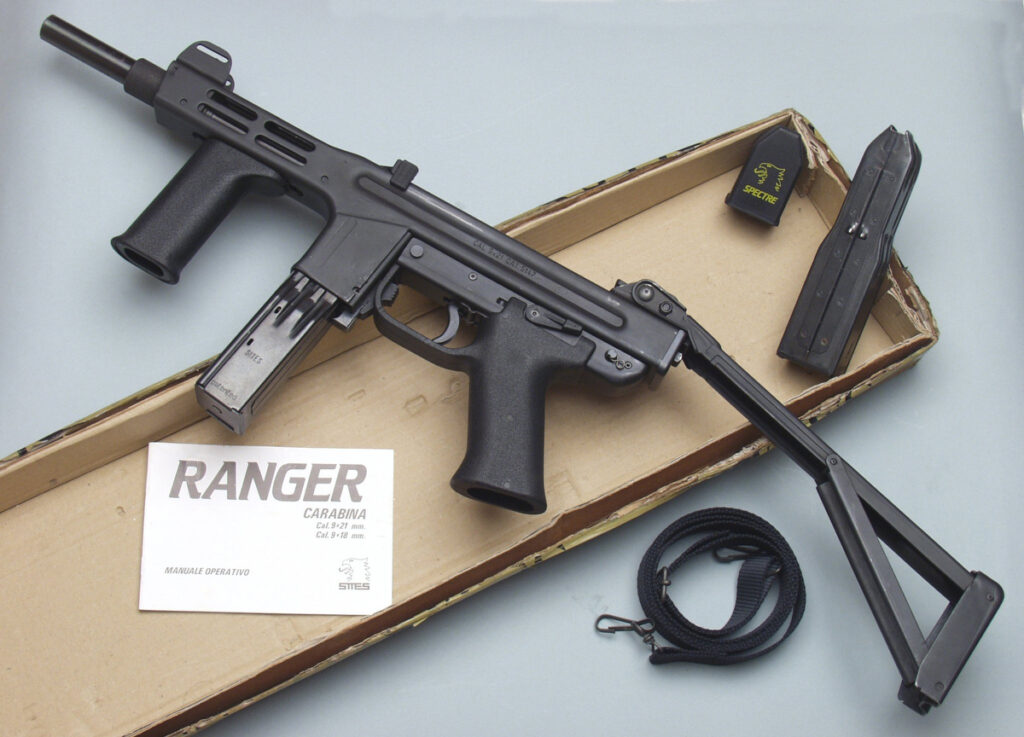
A 16-inch barrel PCC version of the Spectre was advertised briefly on the U.S. market, but, to our knowledge, not many were actually imported. FIE imported approximately 1,500 Spectre HC pistols, all in 9mm Luger, while American Arms imported a gross total of 4,000 samples, over 3,500 of which were in 9mm, only 300 in 40 Smith & Wesson, and less than 100 in 45 ACP.
When SITES closed permanently in 1998, the existing stock of parts for the Spectre M4 and its civilian counterparts was picked up by Claudio Gritti, who moved to Lugano, Switzerland, and established his own company – Greco Sport S.A. – which continued to assemble and sell them until 2001. The legacy of the Spectre M4 lives own, however, with BCM Europearms of Italy still working on the PM4 Storm pistol, which we wrote about on SmallArmsReview.com back in June.
| TECHNICAL SPECIFICATIONS | |
| Make | SITES – Società Italiana Tecnologie Speciali S.p.A. |
| Model | Spectre M4 |
| Type | Sub-machine gun (semi-automatic pistol and carbine versions also available) |
| Caliber | 9mm Luger (also available in 9×21 IMI, 40 Smith & Wesson, 45 ACP) |
| Action | Select-fire, locked breech |
| Trigger system | SA/DA |
| Safety | Manual decocker |
| Capacity | 30 or 50 rounds in proprietary quad-stack magazines |
| Rate of fire | 850/900 rounds per minute (SITES Spectre M4 9mm Luger) |
| Sight systems | Fixed rear, adjustable front post |
| Barrel length | 5.11 in. |
| Total length | 15.5 in., with stock folded or removed, 22.83 in. with stock deployed |
| Weight (empty) | 6.39 lb. |
| Materials | Polymer, steel |
| Finishes | Matte black on all surfaces |



